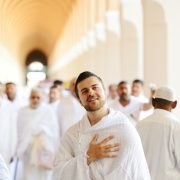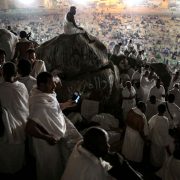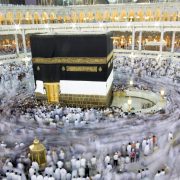Hajj Worship
Reminder: Brief summary of
Hajj Worship
The fifth pillar of Islam, which every Muslim must fulfil once in his life, can only be fulfilled under several conditions :
Being a Muslim
Having reached the age of puberty
Being healthy
To be sane
Having the financial capabilities
This money cannot be financed by borrowing or using illegal money.
The benefits of Hajj are many-sided and have religious, personal, social, moral and educational dimensions. Hajj is one of the five pillars of Islam and was made fard in the 9th year of Hijrah.
Al-Bukhari and Muslim reported that the Prophet (ﷺ) said : « If anyone performs the pilgrimage for God’s sake without talking immodestly or acting wickedly, he will return [free from sin] as on the day his mother bore him. »
« Pilgrimage to the House is a duty owed to Allah by all who can make their way to it. » (Surah 3, verse 97).
Pillars
Pillars of Hajj
The Hajj is based on four pillars*:
*The pilgrimage is declared void if one of these acts has not been performed.
*The pilgrimage is declared void if one of these acts has not been performed.

1st pillar
IHRAM
State of
sanctification

2nd pillar
WAQFAH
Standing on
Mount Arafat

3rd pillar
TAWAF
Circumambulation
around the Kaaba
(Tawaf Al-Ifada after Arafat)

4th pillar
SA’I
Making Sa'i between As-Safa and Al-Marwa
State of sanctification
IHRAM
hram as a state of sanctification must be fulfilled before entering the holy site. Moral sanctity : Men and women express their intention to perform the Hajj in definite terms. Bodily sanctity : men wear a seamless loincloth and a piece of cloth covering the shoulders and sandals. Women keep their clothes on and uncover their faces and hands.
Circumambulation
TAWAF Al-Ifada
The Tawaf Al-Ifada, which is performed after waqfah in Arafat, is a tawaf of 7 rounds around the Kaaba in a counterclockwise direction starting from the black stone or the red line drawn on the ground.
Procession
SA'I
A procession between the two hills (As-Safa and Al-Marwa) inside Makkah, consisting of seven laps starting from Al-Safa. The length of the route is approximately 395 metres.
Standing on Mount 'Arafat
WAQFAF
This obligatory pilgrimage, which is performed from the ninth day of Dhul-Hijjah until the dawn of Eid, is the greatest pillar of Hajj. On this day of great ecstasy, pilgrims beg Allah for forgiveness, mercy and protection at the foot of the Mount of Rahmet (Mercy) in the plain of Arafat.
Arrival in
MINA
In Mina, located between Makkah and Arafat, there are three obelisks representing Satan. Throwing stones at the obelisks consists of throwing seven stones at them. Pilgrims should spend at least two nights there.
Sacrifice
ZABH
It involves the sacrifice of a sheep or cattle in honour of the movement of Prophet Abraham. The sacrifice takes place at any point in the holy region (Mina, Makkah, Muzdalifah).
